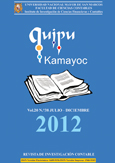ENGINEERING CHARACTERISTICS OF CORRUPTION IN THE ECONOMIC AND FINANCIAL FIELD, AND EFFECTIVENESS OF THE SHARES OF CONTROL IN GOVERNMENT INSTITUTIONS IN PERU
DOI:
https://doi.org/10.15381/quipu.v20i38.4425Keywords:
Corrupción global, corrupción local, presupuesto público, proyectos públicos, presupuesto ejecutado, auditoriaAbstract
Corruption has been responsible for apply a negative lobbying against economic growth; these illegal acts compromise the budgets and governments, and its effects could them dip out in continuous social and economic imbalances. Corruption is not a local phenomenon, but over the time has been perfected for its globalization and in this process has been present the technology; reflected in computer media that facilitated the actions of those who are not interested in the public good, only in his personal interest. Corruption has been responsible for generating of lost for Peruvian government in an average of 14 billion dollars, almost 50% of exports, this figure is the best sign that corrupt acts are still present in society and are continuing to exploit weaknesses that present legal meshes for its penalization. In this context, the aim of this article is to explain the economic and social effects of corruption, and the means of precision that used to avoid all kinds of administrative and criminal responsibilities.
Downloads
Downloads
Published
Issue
Section
License
Copyright (c) 2012 Nicko Alberto Gomero Gonzales, Alberto Eduardo Montes Farro

This work is licensed under a Creative Commons Attribution-NonCommercial-ShareAlike 4.0 International License.
AUTHORS RETAIN THEIR RIGHTS:
a. Authors retain their trade mark rights and patent, and also on any process or procedure described in the article.
b. Authors retain their right to share, copy, distribute, perform and publicly communicate their article (eg, to place their article in an institutional repository or publish it in a book), with an acknowledgment of its initial publication in Quipukamayoc .
c. Authors retain theirs right to make a subsequent publication of their work, to use the article or any part thereof (eg a compilation of his papers, lecture notes, thesis, or a book), always indicating the source of publication (the originator of the work, journal, volume, number and date).






